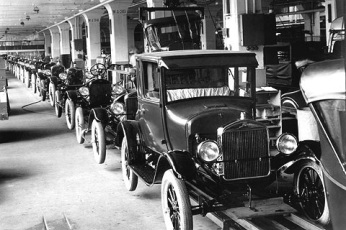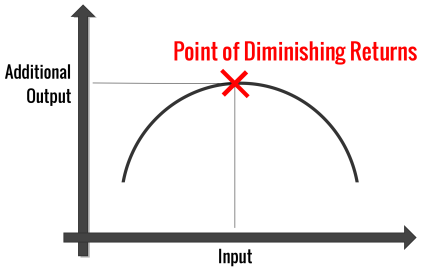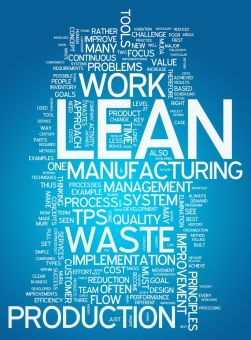In 1913, Henry Ford installed the first moving assembly line for the mass production of an entire automobile. His innovation reduced the time it took to build a car from more than 12 hours to two hours and 30 minutes.
Lean manufacturing is a management philosophy derived mostly from the Toyota Production System and is a systematic method for eliminating waste within a manufacturing system. Lean also takes  into account waste created through overburden and waste created through unevenness in workloads. Lean manufacturing makes obvious what adds value, by reducing everything else which does not.
into account waste created through overburden and waste created through unevenness in workloads. Lean manufacturing makes obvious what adds value, by reducing everything else which does not.
The law of diminishing returns is an economic principle stating that as an investment in a particular area increases, the rate of profit from that investment, after a certain point, cannot continue to increase if other variables stay at a constant. As the investment continues past that point, the return diminishes progressively.
How, and why, should these principles matter to your business? First, at its core, your high-volume photography business is an assembly line. So, let’s look at one aspect of your assembly line to apply these principles. The size of your image files.
Of course, everyone knows that larger image files produce higher quality prints. However, if the largest print size you’ll be delivering is an 8×10, why output files at any higher resolution than needed to produce the quality that meets the standards you’ve established? Are you just shooting RAW and exporting high-quality JPEGS  without much thought about the impact that size will have on your productivity? Just how much thought do you give to the size of your files as they travel through your workflow?
without much thought about the impact that size will have on your productivity? Just how much thought do you give to the size of your files as they travel through your workflow?
Why should you care about this?
Ask yourself, how well would Ford’s assembly line have functioned if any aspect of it was not standardized or was left to chance? We’re using file size for this example, but you should routinely scrutinize all aspects of your business using a systematic method for eliminating waste to optimize the output of your factory — your Engine of Growth.
Let’s do some math. We’ll start with a Project that has 4,000 images. Each with an average size of 18MB each for a total size of 72GB (4,000 x 18MB = 72,000MB = 72GB).
Fast connection speeds are often touted by internet providers, but most people don’t realize that upload and download speeds can vary greatly — with upload speeds being many times slower than download. Running your own speed test will show just how much that difference is for you.  A speed test on the example internet connection revealed a download speed of 34 Megabits per second (Mbps) and an upload speed of 10 Mbps. A Megabit is 1/8 as big as a Megabyte, meaning that to download a 1MB file in 1 second you would need an 8Mbps connection. Mb = megabits and MB = megabytes.
A speed test on the example internet connection revealed a download speed of 34 Megabits per second (Mbps) and an upload speed of 10 Mbps. A Megabit is 1/8 as big as a Megabyte, meaning that to download a 1MB file in 1 second you would need an 8Mbps connection. Mb = megabits and MB = megabytes.
Using this handy online calculator reveals that at 10 Mbps, it will take almost 17.5 hours to upload. But it doesn’t end there. Larger files will also take longer to index, sort, and transfer to your connected platform. Not to mention all the other times you move your image files before and after Snapizzi in your workflow. However, for the sake of this example, we’ll just focus on the single metric of your upload time to Snapizzi.
Let’s say that after testing, you’ve concluded that the smallest size image file to produce a quality print of the largest size you offer is 6MB. The new total project size is now 24GB. You’ve reduced your file size by 66% and shaved 11.5 hours off of your upload time as these images would now take just 6 hours to upload! An improvement of nearly 200% in your efficiency!
Process management is critical to your Project management. If the photography business used in this example is generating 100k images per year — this little change alone will save almost 12 days of uploading time annually!
Still think file size doesn’t matter much?
Are you seeking out waste and inefficiencies in your business to reclaim your precious time and make more money?
If not — it begs the question — why not?
Software built to automate the workflow for high-volume photographers. Try it free!

 — Caitlin Hudnall
— Caitlin Hudnall